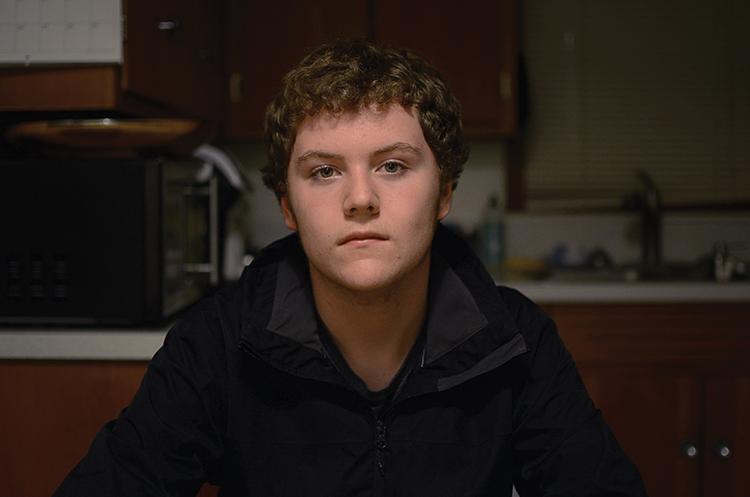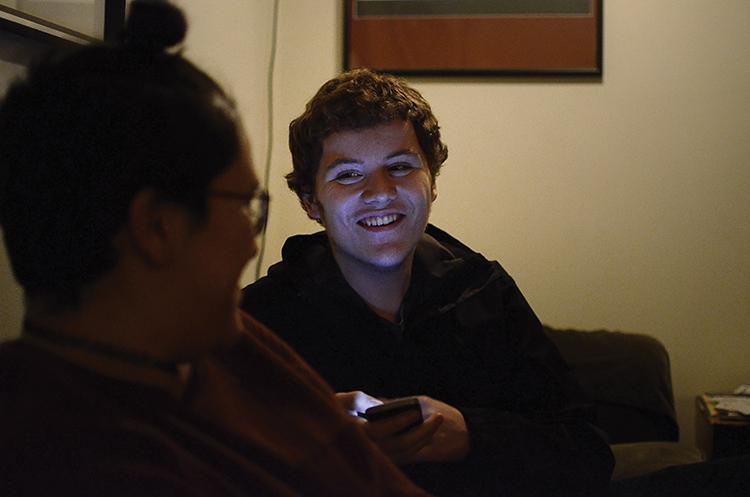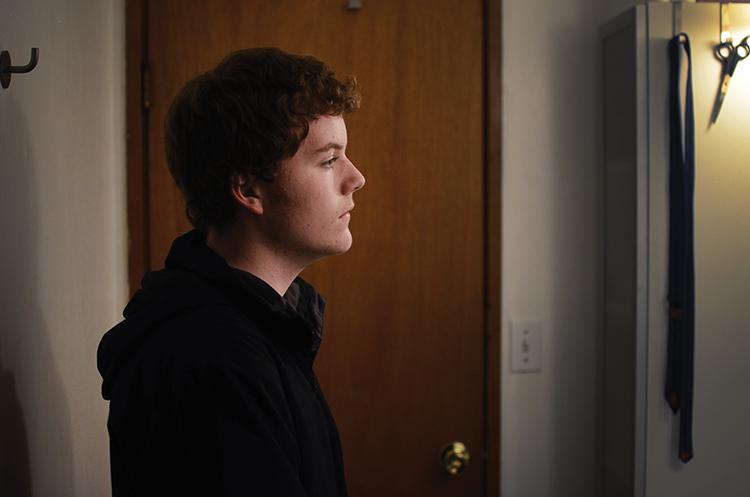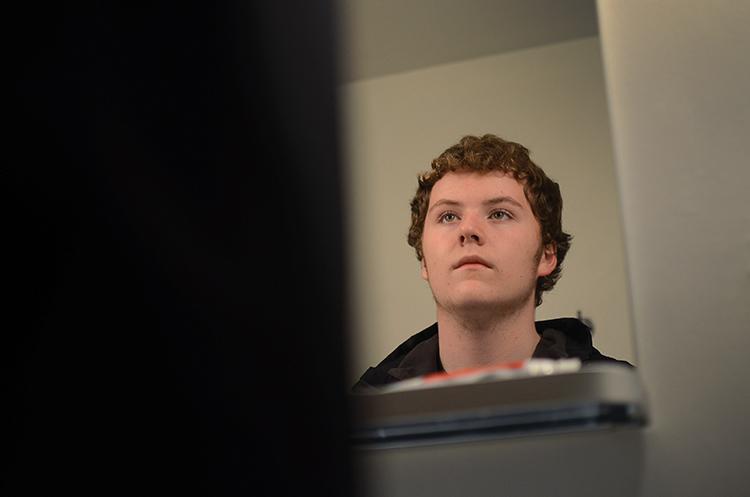Thomas Leonhardt remembers sitting silently in the car. It was a Wednesday in December of 2015. Rain pelted against the windows. He looked outside, and a feeling of unease rushed through him.
His dad, Tom Leonhardt, pulled their Honda Civic across the street from a large white building on the Providence St. Vincent Hospital campus. Thomas Leonhardt was about to enter his first day of treatment for the eating disorder he’d been struggling with for six months.
He became apprehensive as negative thoughts overtook him about the next few months he’d spend at the clinic. “I’m at the stage where I don’t need to be in partial hospitalization,” he remembers thinking. “I didn’t want to go.”
Like many who have eating disorders, Leonhardt – now a freshman at Grant – held little conviction that his issue was anything serious. “Before treatment, I was in denial about it,” he says now. “I just didn’t think I had (one).”
But in reality, Leonhardt was grappling with a deadly mental illness. An article published in the International Journal of Eating Disorders estimates that roughly 30 million people suffer from across the United States. About 4.5 percent of those who have an eating disorder end up dying from the affliction – making it the mental health issue with the highest mortality rate.
Like other mental illnesses, there is no single cause of an eating disorder, says Dr. Naghmeh Moshtael of the Kartini Clinic, a pediatric eating disorder treatment clinic in North Portland. She describes eating disorders as “multifactorial, which like a lot of conditions, some of it is contributed by genetics, some of it is contributed by environment.”
With a society that pressures adolescents to attain a “healthy” body, Moshtael notes the negative impact this can have. “People are advising … everyone else to go lead … healthy lives by dieting and cutting this out and cutting that out of their meal plans,” Moshtael says.
Roughly two-thirds of eating disorder cases in the United States involve girls or women. Boys and men make up about 30 percent of bulimia, anorexia or binge eating disorder cases. Regardless, eating disorders are dangerous across the board. But for teens especially, not having proper nutrition during the last stages of brain development can have a detrimental effect.
Leonhardt’s eating disorder caused severe social repercussions. “I was … isolating myself because I didn’t want to really talk to people because I just wanted to exercise and not eat,” he recalls.
The issue is prevalent at Grant. Despite its relevance and the danger to students, eating disorders continue to stay hidden because people aren’t talking about the issue. The end result leads to an ingrained stigma surrounding it.
Libby Costello-Gard is Grant’s School-Based Health Clinic’s family nurse practitioner. She says it’s typical for people to make judgments about those who have eating disorders. In effect, talking about them can prove uncomfortable for both students and adults.
One Grant junior, who asked for anonymity, says she struggled with anorexia, and she doesn’t want her friends to know. “I really didn’t want to be recognized for (my eating disorder),” she says. “I think that … part of me was also very hidden from people.”
It’s also common for those with eating disorders to deny they have a problem to begin with. In Leonhardt’s case, his unhealthy habits became the norm. “I just had this strange mindset where when I was losing weight, it wasn’t a big deal,” he says. “Like I didn’t see it as being dangerous.”

During the summer before eighth grade, Leonhardt remembers making a commitment to lose weight before high school. Since the beginning of seventh grade, he says he was at a heavier weight and dissatisfied with his body. But until that point, he hadn’t done anything to change how he looked.
He remembers looking at himself in the mirror, as he was filled with a feeling of discontent. He couldn’t stand the thought of people seeing what he saw in the reflection, deciding to stay home so he wouldn’t have to go to the library as he had planned. “I felt like I was disgusting and like I don’t want to be seen,” he recalls.
The cause of eating disorders can be a combination of multiple factors. Whether that’s relative to a poor body image or genetics, it varies from person to person.
The Grant junior says growing up in an Asian-American household held a big influence over her body image. That’s part of what caused her to develop an eating disorder in sixth grade. “I’m like 11, 12 at this time,” she remembers. “I just hop on the Internet, and I’m watching little Asian dramas … I was almost bombarded by these images of like skinny girls. And I started to see myself like them. And I started to really get addicted to that.”
For Leonhardt, what began as trying to lose weight and ridding himself of his negative body image soon spiraled out of control. In an attempt to be healthier, Leonhardt downloaded a calorie counting app and became more rigid about how much he ate. Exercise became a compulsion. “I would dig through the recycling just to know how much calories were on the box … because I felt like I was in control of what I was eating,” says Leonhardt.
Like many others with eating disorders, Leonhardt didn’t recognize he had a problem. He lost his hunger cues, so he thought he was eating enough. But the side effects quickly became evident. Leonhardt became much colder, and his hair began to thin. In order to hide his hairline, Leonhardt stopped brushing his hair back, meticulously wearing it over his forehead.
When he exercised, he developed cramps. He remembers one time on a run where he was trying to get 12,000 steps in, getting a painful cramp in his side. But he had 2,000 steps left, so he felt compelled to keep going. He slowed to a jog and didn’t turn around.
Leonhardt’s parents immediately noticed when his eating habits changed. At first, his father thought his son was being “health conscious, and then it just kept getting … more and more obsessive,” Tom Leonhardt recalls.
His stepmom works as a behaviorist. She quickly identified that Leonhardt was suffering from an eating disorder. At first they tried managing it at home, taking him to see a nutritionist, a therapist and a doctor regularly.
In September last year, he was formally diagnosed with an eating disorder. Leonhardt opposed the diagnosis. “I didn’t think I had a problem,” he says.
His behavior toward his parents changed as they became more concerned with his health. “I just like said a lot of mean things to kind of get at them and like kind of get in their head. I was kind of hell to live with,” says Leonhardt.
The day before Thanksgiving 2015, they took him to an appointment with his nutritionist.
It had been two weeks since Leonhardt had last been there. When Leonhardt was weighed, his parents saw just how much weight he had lost since the last appointment. They knew then he needed more help.
“We don’t know how to stop it. It’s not getting better. He’s lying about it,” Tom Leonhardt remembers thinking. “So we need to find a way to make sure everything’s supervised and get him the help he needed.”
Within a week, Leonhardt’s parents took him to an intake meeting. There, Leonhardt met with a therapist who worked at St. Vincent’s Eating Disorder Clinic. The therapist interviewed him to see what stage he was at with his eating disorder. They tested his cognitive ability and checked his health status.
The therapist recommended that he start going to the clinic. Leonhardt was hesitant to go into treatment, but his parents had already made up their minds. He needed to get help.
“It doesn’t end. It’s like a cycle … I’m sitting there, and I’m like, ‘I want to lose a little more weight,’ and you know it’s unhealthy, but you have to do it. It’s just so addicting” – Anonymous Grant junior
The doctors there told him he needed to go into partial hospitalization, where he would spend seven to eight hours a day, five days a week in St. Vincent’s Adolescent Eating Disorder Treatment Program.
Grant math teacher MaLynda Wolfer knows how Leonhardt felt. She struggled with anorexia during high school and developed similar habits.
“You find a lot of ways to hide that you’re not eating, and so that’s what your mind starts to get wrapped up in. Everything is centered around that focus,” she says.
Leonhardt was able to be quickly diagnosed and receive treatment. But that doesn’t always happen.
“There are a lot of people outside who, first of all, don’t understand what eating disorders are to begin with,” says Moshtael of the Kartini Clinic. “Some are ashamed to talk about it. Sometimes parents and loved ones don’t recognize what’s going on. It’s first the stigma of mental health that leads to not diagnosing it on time. Then it’s the ignorance about eating disorders.”
She notes that quick diagnoses and treatment are essential to combat nutritional deficiency. Brain development comes to a full stop when teenagers aren’t eating enough, she says, though not everyone receives a diagnosis.
A Grant freshman, who also didn’t want her name revealed, developed an eating disorder last year, but she was never formally diagnosed. “I didn’t want to make it a big deal or have people think of me differently,” she says today. She still hasn’t told family or friends.
The Grant junior who doesn’t want her friends to find out also remains undiagnosed. She says her mother would be embarrassed by her daughter having a mental health issue. So it gets pushed aside. At the doctor’s office, her mom often blames her daughter’s low weight on having a fast metabolism.
“It’s almost like it’s considered embarrassing to have problems,” the junior says. “That embarrassment of knowing that you do have that type of problem … you just want to deny it so bad.”
As her undiagnosed disorder continued, the side effects worsened. The junior remembers walking out of the shower feeling and dizzy at once. This wasn’t an uncommon side effect, but as she left the bathroom this time, she blacked out and hit her head hard against the wall. The next thing she knew, her mom was hovering over her in a panic. “My mom knew why I passed out, but she didn’t want to accept it,” she remembers.
Though the junior knew she was unhealthy, her lack of a diagnosis made it feel unreal. “To me, it’s never official unless you get diagnosed,” she says.
It isn’t uncommon for eating disorders to also be misdiagnosed as other health issues. Costello-Gard of the Grant Student Health Center says she often receives patients coming in for depression or anxiety. After talking with them, she identifies some of their symptoms in correlation with eating disorders.
“I really didn’t want to be recognized for (my eating disorder) … I think that … part of me was also very hidden from people” – Anonymous Grant junior
Leonhardt was fortunate enough to receive the treatment he needed. He attributes his partial hospitalization to a major part of his recovery. Because he was so heavily monitored, Leonhardt had no choice but to get better.
St. Vincent staff were strict when it came to the health of their patients. Leonhardt wasn’t allowed any activity at first. Even grocery shopping with his parents was too much movement because rapid weight loss leads to a weak heart rate.
Treatment at St. Vincent’s involved group therapy and meals. Because he was out of school for a long period of time, Leonhardt became isolated from his school, friends and his daily routine. He says simply: “It was almost like I fell off the face of the Earth.”
Nonetheless, he became close with other patients. “It’s just nice to have that group of people that actually know and not just feel sympathetic … who’ve actually gone through the same thing,” he says.
Two months after he entered treatment, Leonhardt came back to school. For him, the transition was smooth. His teachers had excused him from his missed schoolwork.
However, going back to school can be an added stress for many patients. Social and academic pressure can prove too much for some students. Rebecca Dorn, one of Grant’s school psychologists, says it’s common for students to need a reduced schedule in order to manage their return.
Though Leonhardt came back to school, he was heavily monitored. With a restricted activity level, Leonhardt was given the school’s elevator key to avoid the stairs. He wasn’t open about it, as he considered his eating disorder to be a “personal” issue.
When peers asked where he had been, he told them it was “medical stuff.” He didn’t want them to judge him for having an eating disorder.
Like Leonhardt right after treatment, many students are reluctant to talk about the problem due to it being seen as humiliating. Costello-Gard says there are misperceptions that make people closed off about eating disorders. “People have this thought that it happens to kids who don’t care enough about their bodies or their parents aren’t paying close attention,” she says.
But now at Grant, Leonhardt has become less closed off about his eating disorder. If people ask about it, he’ll tell them.
. . .
Though Leonhardt has been out of treatment for eight months, there are still everyday struggles that accompany his transition back to a normal health. Without intention, he still looks at nutrition labels and can remember how many calories are in a gram of fat. Though it isn’t a major part of his life, it’s something he still thinks about. “You can recover and still have that piece of you,” Leonhardt says.
His parents don’t monitor him as much as they did during treatment, but they are still cautious when it comes to his food intake. Leonhardt manages his eating disorder now by seeing a nutritionist, a therapist and a psychiatrist on a regular basis.
Moshtael stresses that though eating disorders are considered chronic, a full recovery is plausible. “There are plenty of our kids who live full lives. They have wonderful professions. They have families. They move on with their lives,” she says.
Wolfer sees herself as fully recovered. “There are definite points in my life where it becomes easier to focus on like that one track thing,” she says. “It’s not as much a struggle for me as an adult because I find ways to center myself or stay busy.”
However, others don’t feel they have fully recovered. The Grant junior finds it easy to slip back into old thoughts. “It doesn’t end. It’s like a cycle,” she says. “I’m sitting there, and I’m like, ‘I want to lose a little more weight,’ and you know it’s unhealthy, but you have to do it. It’s just so addicting.”
Leonhardt is determined to stay in recovery. He doesn’t want to go back to treatment. His father has his concerns, though. “I’m … worried because there’s a high relapse for these kinds of things. You have to be vigilant,” Tom Leonhardt says.
The Grant junior believes that having a conversation about eating disorders is what will help the stigma to go away. She wishes she could start that conversation.
“I want to have other people be able to feel like there’s more people out there that’s like them, and there’s more people that they can talk to,” the Grant junior says. But she’s reluctant to tell others. “I want people to look at me for me, not for my problems.”
Costello-Gard agrees that change needs to occur in order to eliminate the stigma. “It’s not just something we can fix here in Grant,” says Costello-Gard. “It takes a huge group of people to make that stand.” ◆








